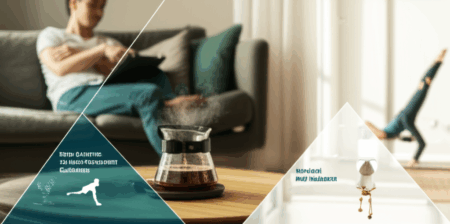Higher education institutions worldwide are grappling with a significant rise in mental health challenges among their student populations, including high levels of anxiety and stress. Young adults are recognized as a particularly vulnerable demographic for mental health issues. In response to this growing concern, there’s a critical need for effective mental health interventions that positively influence students’ emotional and behavioral well-being. The “Intervention Mapping” (IM) framework offers a robust and systematic approach to designing such programs, ensuring they are evidence-based, theory-driven, and tailored to the specific needs of university students.

Understanding the Landscape of Student Mental Health
University life presents a unique set of stressors, from academic pressure and financial difficulties to social integration and the transition to adulthood. These factors contribute to elevated levels of stress, anxiety, and psychological distress, which can negatively impact academic performance, social relationships, campus engagement, and overall quality of life. Studies indicate a substantial portion of students experience mental health difficulties, with some reports showing as many as 40% of further education students experiencing issues in their first year. Poor mental health has also been linked to lower retention rates, grade point averages, and graduation rates.
Common mental health problems among university students include depression and severe anxiety, highlighting the urgent need for accessible and effective interventions. While various interventions exist, a systematic approach to their design and implementation is crucial for maximizing their impact.

Intervention Mapping: A Strategic Framework for Program Design
Intervention Mapping (IM) is a comprehensive health promotion planning framework that guides the development, implementation, and evaluation of interventions. It is particularly well-suited for designing complex, multi-faceted interventions in higher education settings because it emphasizes a structured, systematic process. The framework ensures that interventions are grounded in scientific evidence and psychological theories, increasing their potential effectiveness.
The Six Steps of Intervention Mapping
IM typically involves six chronological steps, though the process is iterative, allowing planners to move back and forth between tasks as needed:
- Step 1: Needs Assessment and Problem Analysis: This initial step involves thoroughly understanding the mental health issues faced by the target population (university students). It includes identifying what needs to be changed, for whom, and why. This can involve gathering mixed qualitative (e.g., Delphi technique, focus groups) and quantitative data (e.g., surveys) to gain a broad perspective on concerns and learning needs.
- Step 2: Creating Matrices of Change Objectives: Based on the needs assessment, this step involves defining desired behavioral and environmental outcomes and identifying the determinants (e.g., knowledge, attitudes, skills, social support) that influence these outcomes. These are then combined to create “change objectives,” which specify what needs to be changed in whom to achieve the desired health outcomes.
- Step 3: Selecting Theory-Based Intervention Methods and Strategies: In this crucial step, evidence-based behavior change techniques (BCTs) are selected that align with the identified determinants and change objectives. These BCTs, which are theoretically proven strategies (e.g., goal setting, modeling, active learning), are then translated into practical applications and program materials.
- Step 4: Designing the Program: The selected strategies are integrated into a cohesive and organized program. This involves developing the program’s structure, content, and materials, ensuring they are tailored to the specific needs and context of higher education students.
- Step 5: Planning for Adoption, Implementation, and Sustainability: This step focuses on how the program will be put into practice and maintained over time within the university setting. It involves identifying key stakeholders, program adopters, and implementers, and determining their needs to ensure successful rollout and long-term viability.
- Step 6: Generating an Evaluation Plan: The final step involves developing a plan to evaluate the program’s effectiveness (effect evaluation) and the fidelity of its implementation (process evaluation). This ensures that the intervention’s impact on student mental fitness can be measured and refined.

Evidence-Based Interventions for Student Mental Health
Research highlights several promising approaches for improving student mental health, many of which can be integrated into IM-designed programs:
Mindfulness and Cognitive-Behavioral Interventions
Mindfulness-based interventions (MBIs) and cognitive-behavioral therapy (CBT) are widely recognized as effective for addressing mental health challenges in university students.
- Mindfulness-Based Stress Reduction (MBSR) and Mindfulness-Based Cognitive Therapy (MBCT) have shown effectiveness in alleviating stress and anxiety, with MBCT focusing on reframing thoughts.
- Cognitive-Behavioral Therapy (CBT)-related interventions have demonstrated significant reductions in depression and anxiety symptoms. Programs focusing on CBT, coping skills, and building social support networks are particularly effective in reducing stress.
Physical Activity and Lifestyle Approaches
Physical activity is increasingly recognized as a vital component of mental well-being in higher education settings. Structured exercise programs can effectively address mental illness and promote well-being among students, serving as an adjunct to clinical therapies. Combined physical activity interventions with mindfulness-based therapy (PAI + MBT) have shown strong and consistent effects in reducing stress and depression among university students.
Holistic and Integrated Approaches
A holistic approach that embraces the individuality of students is encouraged for university-based interventions. The “4M-Model” suggests focusing on elements of mindfulness, movement, meaning, and moderator to address students’ physical, psychological, emotional, and social needs. Programs that integrate multiple evidence-based strategies, such as physical activity with mindfulness, or cognitive-behavioral techniques with social support, tend to yield more comprehensive benefits.

The Role of Theory and Data in Intervention Design
The power of Intervention Mapping lies in its emphasis on theory and data. By systematically applying theoretical frameworks and gathering comprehensive data, programs can be designed to target the underlying determinants of mental health issues. For instance, the “Be Well Plan,” an intervention guided by the IM approach, focuses on self-exploration to help individuals understand their motivators, resources, and challenges, leading to personalized mental health and well-being plans.
Furthermore, the IM framework facilitates the clear articulation of behavior change techniques, ensuring that the chosen methods have an empirical basis for influencing behavior. This rigorous approach moves beyond general psychoeducational programs, which often show limited effectiveness when presented as information alone. Interventions with supervised skill practice, particularly mindfulness programs, have demonstrated higher effectiveness.
Conclusion
The increasing prevalence of mental health issues among university students necessitates a proactive and evidence-based approach to intervention design. The Intervention Mapping framework provides a systematic and comprehensive methodology for developing “mental fitness” programs in higher education. By meticulously analyzing needs, selecting theory-driven strategies, and planning for robust implementation and evaluation, universities can create impactful interventions that foster resilience, promote well-being, and ultimately support students’ academic success and overall quality of life. The continued application of frameworks like Intervention Mapping, combined with ongoing research into effective intervention models, will be crucial in addressing the evolving mental health landscape in higher education.







